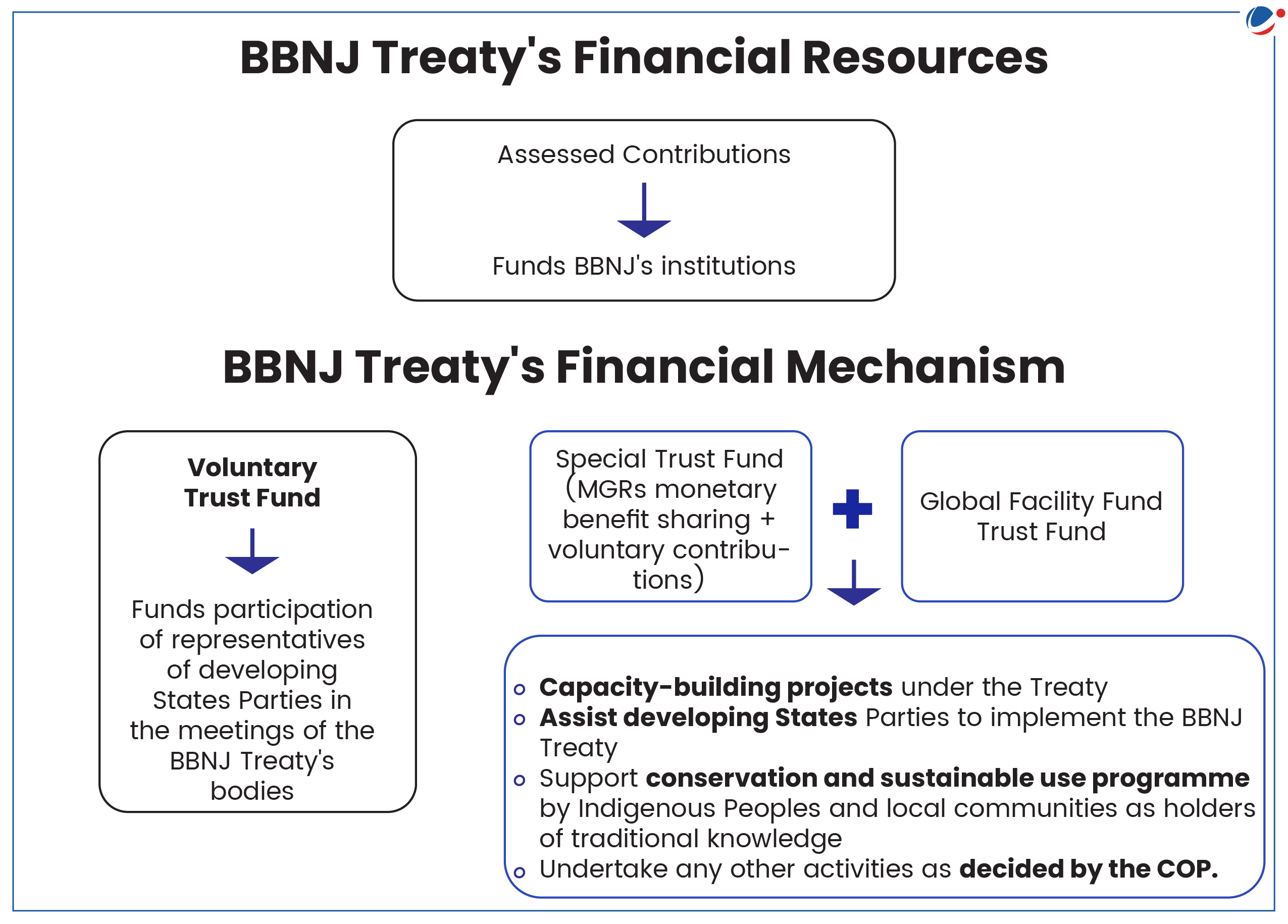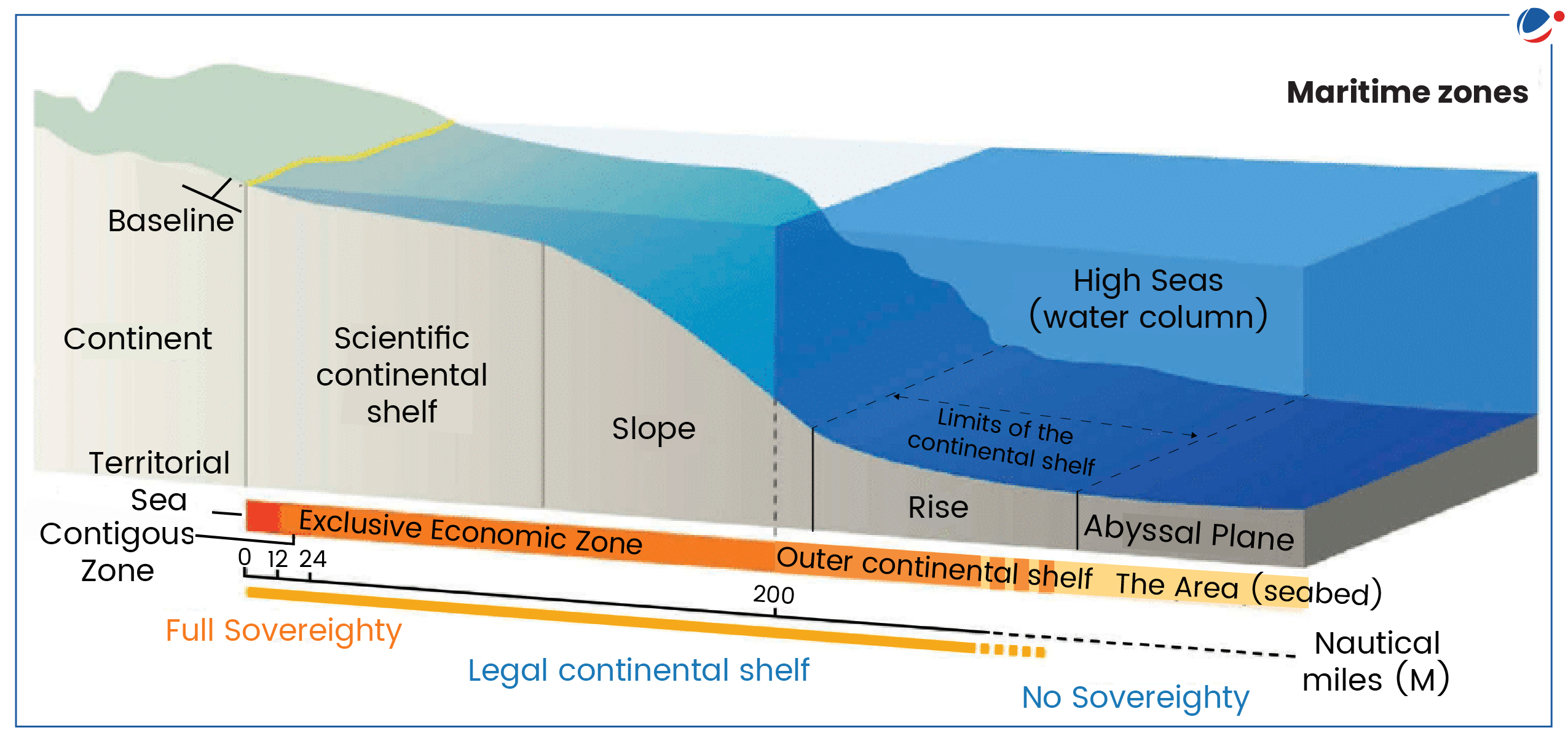Why in the news?
Union Cabinet has approved India to sign the Biodiversity Beyond National Jurisdiction (BBNJ) Agreement, also known as the High Seas Treaty. The Ministry of Earth Sciences will spearhead its implementation.
What are High Seas?
- Definition: High seas are areas outside the national jurisdiction of any country.
- Typically, national jurisdictions extend up to 200 nautical miles (370 km) from the coastline, an area called Exclusive Economic Zone (EEZ).
- Global Commons: High Seas constitute about 64%, roughly two-thirds, of the total ocean area and are considered global commons.
- They belong to no one, and everyone enjoys equal rights for navigation, overflight, economic activities, scientific research, or laying of infrastructure like undersea cables.
BBNJ Agreement
- Name: It is formally called the Agreement on Conservation and Sustainable Use of Marine Biological Diversity of Areas Beyond National Jurisdiction.
- Under UNCLOS: It is an international treaty under the United Nations Convention on the Law of the Sea (UNCLOS).
- BBNJ Agreement will be the third implementation agreement under UNCLOS if and when it enters into force, alongside its sister implementation agreements:
- 1994 Part XI Implementation Agreement (which addresses the exploration and extraction of mineral resources in the international seabed area) and
- 1995 UN Fish Stocks Agreement (which addresses the conservation and management of straddling and highly migratory fish stocks).
- BBNJ Agreement will be the third implementation agreement under UNCLOS if and when it enters into force, alongside its sister implementation agreements:
- Adoption: Agreement was adopted in 2023 and is open for signature for two years.
- It will be an international legally binding treaty after it enters force 120 days after 60 countries ratify it.
- As of June 2024, 91 countries have signed the BBNJ Agreement, and eight Parties have ratified it.
- Objective: To ensure the conservation and sustainable use of marine biological diversity of areas beyond national jurisdiction, for the present and in the long term.

Key Provisions of BBNJ Agreement

- Scope of application: It applies to Areas Beyond National Jurisdiction (ABNJ), which include the high seas.
- It does not apply to any warship, military aircraft or naval auxiliary.
- Only Part-II, which deals with Marine Genetic Resources, applies to any government vessel in non-commercial service.
- Institutional Arrangement: Treaty establishes:
- Conference of Parties (COP): COP will consist of the Parties to the Treaty and is the main decision-making body (except for certain matters on environmental impact assessments).
- Scientific and Technical Body (STB): STB will provide scientific and technical advice to the COP.
- Clearing-House Mechanism (CHM): CHM will be primarily an open-access platform and serve as a centralized platform.
- It will enable Parties to access, provide and disseminate information on the four substantive elements of the BBNJ Treaty.
- Subject-Matter Committees: These include access and benefit-sharing committee, capacity-building and transfer of marine technology committee, finance committee, and Implementation and Compliance Committee.
- Financial Mechanism: It establishes a financial mechanism that will provide adequate, accessible, additional and predictable financial resources, which will function under COP.
Four Substantive Elements of BBNJ Treaty | |
Marine Genetic Resources, including the fair and equitable sharing of benefits |
|
Measures such as Area-Based Management Tools, including Marine Protected Areas |
|
Environmental Impact Assessments (EIAs) |
|
Capacity-Building and the Transfer of Marine Technology |
|
Significance of BBNJ Agreement
- Biodiversity Conservation: By checking overexploitation of resources, biodiversity loss, pollution, including dumping of plastics, ocean acidification, and many other problems.
- According to UN estimates, about 17 million tonnes of plastics were dumped in the oceans in 2021.
- Mitigating impacts of Climate Change: On marine ecosystems, such as warming, ocean deoxygenation, ocean acidification, etc.
- Equitable economic order: Agreement will help realize a just and equitable international economic order which takes into account the interests and needs of developing States, whether coastal or landlocked.
- Significance for India:
- Strategic expansion: BBNJ Agreement allows India to enhance its strategic presence in areas beyond our EEZ (Exclusive Economic Zone), which is very promising.
- Resource Benefits: In addition to shared monetary benefits, it will strengthen India's marine conservation efforts and collaborations, open newer avenues for scientific research, capacity building and technology transfer, etc.
- Promotion of traditional knowledge: It follows an inclusive, integrated, ecosystem-centric approach based on the precautionary principle and promotes using traditional knowledge.
Conclusion
A growing recognition of critical role of the vast oceanic realm has led to finalization of long-awaited BBNJ agreement. The agreement will play a crucial role in achieving the recent ambitious "30x30" initiative to protect 30% of marine ecosystems by 2030.
UN Convention on Laws of the Seas (UNCLOS)
|



